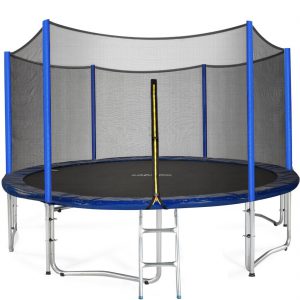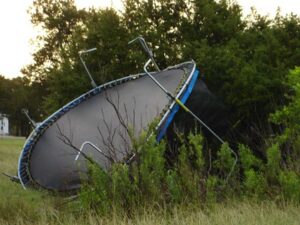Can You Store A Trampoline Upside Down? An Interesting Winter Storage Idea
Winter is approaching, and you’re wondering what to do with your backyard trampoline, especially considering the lack of storage space you have available. Should you just leave it out and hope the snow doesn’t stretch out the mat, or disassemble it completely and just squeeze it in somewhere? Perhaps there is another option. Maybe you’ve wondered “can I flip my trampoline over for the winter”? We’ll look at the idea of storing a trampoline upside down today.
You can store a trampoline upside down for winter. However, you do need to remove some important parts, tarp it extremely well, and weigh it down. There are some key reasons why it’s not the BEST idea, but all things considered, yes, you can flip a trampoline over to protect it against winter storms.

How To Store A Trampoline Upside Down For Winter
If you want to give it a try, here’s how to go about it. Quick overview first, then more info to follow.
- Disassemble a few necessary parts (obviously the trampoline enclosure net is part of this).
- Flip your trampoline onto a flattened tarp (you’ll need a few strong friends or a pulley system)
- Lay down any parts that you’ve disassembled (if you can’t store them).
- Cover and wrap everything well with tarps (including the upright legs, the mat, and especially the springs).
- Weigh it all down.
What Parts Do Need To Be Disassembled
Although flipping over your trampoline will save you time and energy on removing all of the springs and disassembling the legs, there are parts of the trampoline that will still need to be taken apart.
Safety Net and Poles (And What To Do With Them)

After removing the safety net enclosure (check your trampoline manual for disassembly instructions), you can bag or wrap up the items and eventually lay them on top of the flipped trampoline. Try to package them as flat as possible.
The Pad Covering The Springs (And What To Do With Them)
The spring protection pad is one of the first parts of any trampoline to go, so you do want to take as much care with it as possible because they aren’t cheap to replace. Removing it, and packing it away in a storage location that is guaranteed to be dry is best, but if you have no room for it, fold, tarp, and bag it well prior to laying on the flipped trampoline bed.
If it’s not wrapped securely, there are chances of mice burrowing in. Tuck in some Bounce dryer sheets… mice hate the smell! There is also a greater potential for mold or mildew growing on them, if moisture can get in. The material is designed to be weatherproof, and mold and mildew can be attacked in the Spring with some good bleach and water (and strong sunlight), so don’t worry too much about it. Just wrap well.
What you also want to watch out for is that NO ONE steps on the mattress pad pile while it lies frozen and potentially covered in ice and snow. The heap may be appealing for your kids to climb on after a fresh snow, but the cover of the padding will be much more likely to crack and split from the pressure when it’s freezing cold and stiff.
Supplies Needed To Winterize Your Flipped Trampoline
You’ll need to purchase or locate a few supplies for winterizing your trampoline upside down.
- Tarps (and lots of them)
- Rope, duct tape, or bungee cords
- Sandbags or bricks
Flip It Over: A Pulley System Makes Flipping Over A Trampoline Easy
Trampolines are heavy (especially those gymnastic trampolines)! If you like the idea of storing your trampoline upside down, you’ll have to use some muscles to get it done. Having a few friends quickly help you share the weight load is the easiest, but if it’s just you and your spouse, consider getting a pully system such as this one here.
You’ll see it in use in the video below. This 150 pound trampoline was flipped over in the wind. If you watch it, you’ll see how the gentleman used a simple pulley system to almost effortlessly flip the trampoline over again.
After Flipping It Over... Then What?
After you’ve figured out how to flip it over, and you have it laying nicely on a tarp on the ground, with the legs up in the air, the next step is to lay down whatever disassembled parts you can’t store elsewhere.
Once your “pile” is made, now it’s time for all of those tarps to start getting put down. Make sure they are heavy duty waterproof tarps.
Yes, you do want to cover the legs, as water may find its way in through cracks or rivet holes, and standing water in metal is rust-waiting-to-happen.
The springs are super important to cover well as well, as these are often the first parts to rust due to moisture. You can tuck the tarp under the trampoline around them fairly easily.
Your last step is to weigh down both the tarps and flipped trampoline. The last thing you want is to see a massive tarp go flying during a blizzard, or worse yet, the trampoline get pulled onto its side by a crazy gust of wind. (While this last scenario is very unlikely, you don’t really want to test it out.) Weigh it down.
Why You Might NOT Want To Store Your Trampoline Upside Down
So the question posed was “Can You Store A Trampoline Upside Down?” And The answer was yes, it can work just fine, and saves you storage space. HOWEVER, there are several reasons why you may not want to actually go this route.
1) The flat circle will destroy any grass growing underneath it.
You’ll definitely want to flip the trampoline back on its legs as soon as you can, as soon as threat of heavy snow has passed. Even then, you may be requiring some grass seed where it was lying.
2) The big tarped heap will be quite the eyesore in your backyard.
Besides being an eyesore, it may be a challenge to keep pets and children off of it during winter outdoor play.
3) You do have a risk of mice making their home under the tarp.
The trampoline mat is made from a waterproof woven polypropylene (which isn’t their preferred material), but the area is protected from the wind, snow, and rain.
4) Even the best tarps are no guarantee against moisture.
Tarps will weather and rip, especially during bad storms. And if moisture collect on the trampoline mat and cover pads, you may be dealing with mold and mildew. Water on the springs may bring premature rusting.
Flipping Your Trampoline Prior To A Heavy Wind Storm
Is It Effective Protection?

If you are told that a hurricane is coming, and you want to make sure your backyard trampoline is going to survive it, flipping it over is one way you can attempt to minimize any damage – to stop it from looking like the one in the photo here.
Flipping it over takes away the “sail effect”, which is what causes the trampoline to lift like a sail being thrown in the wind.
You will want to sandbag or weigh it down as evenly and well as possible however.
It's Not A Quick, Last Minute Solution
Flipping a trampoline and weighing it down, taking away the wind tunnel effect is something that you can’t just do in 5 minutes. But if you have some advance notice of a bad storm coming your way, and have time to do some prep work, give it a go. If it were me, I wouldn’t bother with any tarps in this situation, but would find space somewhere safe for the spring cover mat and safety net closure.
Final Thoughts
So, the answer to the question of “can you store a trampoline upside down” is a qualified yes. It CAN be done, after you remove key parts, and only if you tarp it very well and weigh it down. However, there are several really good reasons why it’s not the best way to winterize a trampoline.






